
Whose garbage is it, anyway?
This is a picture of the enormous garbage dump in Meethotamulla as seen from the HNB tower in Colombo 10. The photos show garbage is being pulled up by excavators. Pix by Waruna Wanniarachchi – See more
Pix by Waruna Wanniarachchi.
Source – 14/03/2017, Dailymirror,See more at: http://www.dailymirror.lk/article/Whose-garbage-is-it-anyway–125418.html#sthash.riy1UDrb.dpuf

One-minute video competition to mark International Day of Forests
The International Day of Forests (IDF) is celebrated globally on 21st March each year under the auspices of the Food and Agriculture Organisation (FAO) of the United Nations.
This global celebration of forests is used as a platform to raise awareness of the importance of all types of forests and of trees outside forests for the benefit of current and future generations. Therefore,on each International Day of Forests, countries are encouraged to undertake local and national efforts to organize activities involving forests and treesunder an annual theme.
While this year’s global IDFtheme will concentrate on Forests and Energy, FAO Sri Lanka is joining forces through the Sri Lanka UN-REDD Programme with the Forest Department and Climate Change Secretariat of Sri Lanka, as well as SLYCAN Trust, Thuru App Team and IUCN Sri Lanka to organize a one-minute video competition under the theme: Value of Forests. Market leader of Sri Lanka’s cement industry INSEE Cement has come forward as the private sectorsponsor of the event. “Forests play an important role in fighting global warming and regulating climatic conditions.
People all over the world are now uniting to protect existing forests and to increase forested areas in order to face this common threat,” states FAO Representative in Sri Lanka Ms Nina Brandstrup. She further stressed the need to create awareness on the need to protect forests and highlight the benefits forests provide through creative means.
The one-minute video competition aims to create awareness on the important role played by foreststhat include fighting climate change; regulating weather patterns; providing livelihoods; preserving biodiversity; ensuring water security; preventing natural disasters; and maintaining soil quality, among other.
The competition, which is open to all citizens of Sri Lanka encourages entrants to develop an MP4 or AVI video of a maximum duration of 1 minute, which could be filmed using a video camera, a smartphone, or computer-generated animation or a combination of all these.
The video would be judged on creativity, relevance to theme and clarity of message. The winner of the 1st Prize will be awarded with a cash prize of Rs. 100,000 by INSEE Cement with the 2nd and 3rd prizes being set at Rs. 75,000 and Rs 50,000 respectively .
Source – See more at: http://www.dailymirror.lk/article/One-minute-video-competition-to-mark-International-Day-of-Forests-125392.html#sthash.BZOdUewl.dpuf

Stop landfilling and building on reservation land: Farmers in Kataragama

They allege marshy wetlands are being filled to build hotels, rest houses and restaurants and that around 1000 acres of irrigation land would be destroyed if this landfill continued.
The Grama Niladhari divisions worst affected include Kataragama, Sella Kataragama, Kandasurindugama, Detagamuwa and Karavile covering the Kataragama Divisional Zone.
Businessmen from the towns are coming to their villages and threatening the livelihood of around 5000 families. The filling of irrigation tanks and the river basin is making paddy cultivation more and more difficult, Janasetha Farmers’ Association Secretary, W.A.K.Piyadasa said. He added generations have lived in these areas using water from these tanks and they have to be protected.
Anyone who comes to Kataragama or Detagamuwa can witness the construction of parapet walls coming up around hotels, guest houses and swimming pools that are being built. These have been mentioned in the petition submitted to the President and the Prime Minister, Mr. Piyadasa said.
He alleged that the landfilling has affected Goyagala wewa, Kohombha wewa, Chandere wewa, Kukulkatuwa wewa, Gerikatu wewa, Samurdhi wewa and the Akkara Visse wewa and the reservation areas have been forcefully encroached upon.
The farmers allege that the businessmen have prepared forged documents to show ownership of these reservation areas.
Janasetha Farmers’ Association president, Chief Incumbent of the Kirivehera, Kataragama, Ven. Kobawaka Daminda Thera said they had informed the authorities in writing about these activities.
He said the Goyagala wewa irrigated some 125 acres of paddy and sustained 48 farming families. The water capacity of this tank had drastically reduced due to unauthorised filling. “This is only one example. But the situation is similar with regard to 20 irrigation tanks surrounding the divisional area. We hope that the Presidential Task Force on Environment will carryout a probe on the matter,” the Thera said.
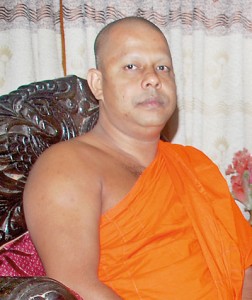
Meanwhile Kataragama Divisional Agrarian Services Development Officer Sunil Sriyananda said he had received similar complaints. “These lands are managed by the Divisional Secretariat” he said, adding that the tank reservation areas need to be surveyed before claims of encroachment of these areas are looked into,” he said.
Commenting on the matter, Kataragama Divisional Secretary, S. Weerakoon said the land area under the Divisional Secretariat is around 80,000 acres and about 80% of this land has been demarcated as forest reservations. “Some people prepare forged documents and sell lands to businessmen,” he said.
Moneragala District Secretary Mrs. D.S.Padmakularuriya conceded that unauthorised constructions had come up in these reservation areas in Detagamuwa.
http://www.sundaytimes.lk/170312/news/stop-landfilling-and-building-on-reservation-land-farmers-in-kataragama-232452.html

The duck who caught the attention of Dutch Governor Gideon Loten
A recent spotting of a male and female Comb duck pair at Deberawewa, Tissamaharama. Pic by Palitha Anthony
The Comb duck, or Knob–billed duck (Sarkidiornis melanotos), has been observed by bird watchers and naturalists in Sri Lanka since June 2012. The unusual looking large duck has a worldwide distribution. It is found in tropical wetlands in Sub-Saharan Africa, Madagascar and South Asia from the Indian subcontinent to Laos and extreme southern China. It also occurs in continental South America south to the Paraguay River region in eastern Paraguay, south-eastern Brazil and the extreme northeast of Argentina, and as a vagrant in Trinidad.
The awareness of the Comb Duck’s presence in Sri Lanka stretches as far back over two and a half centuries. The species was first collected and recorded between 1752-1757 during the administration of the Dutch Governor Gideon Loten (1710-1789).
It was present in the neighbourhood of Colombo which was a part of the Maritime territories under Dutch rule.The original water colour and sketch of this duck formed a part of a portfolio of 154 illustrations in colour and was brought to England by Loten in 1859 and is now a part of the British Museum’s Natural History collection. The majority of the drawings were executed by the Sri Lankan artist Cornelius de Bevere (c.1722-1781).
Gideon Loten’s rise to eminence in England and Europe among the 18th century scientific world has been attributed to the stimulus generated by the drawings of Pieter Cornelis de Bevere. Loten was elected as a Fellow of the Royal Society, London in November 1760 and a large monument dedicated to him stands in the central aisle of Westminster Abbey.
The body of work that Loten amassed of this artist had serious impact on the leading naturalists and scientists in the latter half of the 18th century both in England and Europe. Hitherto, there were very few accurate illustrations or descriptions of the fauna of Sri Lanka available to the scientific world.
Among Loten’s associates and correspondents in Europe were the famous Swedish scientist Carl Von Linnaeus,(1707-1778) who promulgated the concept of binomial classification and Johann Reinhold Forster (1729-1798), the naturalist who accompanied Captain James Cook (1728-1779) on his second voyage around the world. In England, they were Sir Joseph Banks (1743-1820) (President- Royal Society London from 1765-1804), Sir Thomas Pennant F.R.S. (1720-1781), George Edwards.F.R.S. (1694-1773) and Peter Brown, the Danish naturalist.
Copies of de Bevere’s work were executed for Banks by his natural history artist Sydney Parkinson (c1745-1771) who both accompanied Captain Cook on his first voyage around the world. Engravings based on these drawings were also executed by Peter Mazell (c.1761-1797) for Pennant’s work, Peter Brown and Johann Reinhold Forster (1729-1798). At least five independent works were published in English and German containing copies of engravings based on de Bevere’s original sketches, which included Pennant, Edwards, Brown and Forster.
Loten made extensive notes evident from the inscriptions on the reverse of the drawings. Often the text accompanying the plates was extracted from these notes often based on information supplied by de Bevere and recorded by Loten. De Bevere was employed as a land surveyor by the Dutch East India Company during the administration of Gideon Loten, Dutch Governor of the Maritime territories 1752-1757, and was trained as a natural history artist under the latter’s supervision.
The first description of the Comb duck in science was by Johann Reinhold Forster in 1781 from an illustration based on an original painting by de Bevere from a specimen collected in Sri Lanka between 1752-57.The technical term describing or assigning a scientific name in the absence of an original specimen from an illustration is termed as icon type. It is ‘strictly, an illustration that formed the sole basis for a new species name’, not necessarily with a description unless the illustration remained unpublished. Nevertheless when a type specimen has not survived then their illustration whether published or not has great importance. In this respect, an original drawing is usually superior to a published one, hence the continued value of early drawings to taxonomy. Hence several of Pieter Cornelius de Bevere’s drawings now in the BM and other institutions in this respect are of primary importance to scientists and zoologists, as some species have become extinct like the Dodo or the passenger pigeon. Thomas Pennant writing in Indian Zoology (1791.page 1) commented,“That the species of Goose we describe is extremely common in Ceylon” which fact was further confirmed by Reinhold Forster who described it in his work Indische Zoologie (1781).
Almost a century later the British naturalist Edgar Leopold Layard (1824-1900)- noted that the bird was common in the Eastern Province (1856). Holdsworth also commented that it was reasonably well distributed. (P.Z.S.1872) as did Kelaart (1819-1860), Hume (1819-1912) and Parker (c.1879-1906).

In the last quarter of the 19th century, Hugh Neville of the Ceylon Civil Service who amassed one of the largest collection of bird skins published his varied researches including natural history notes in the Taprobanian (1886)), quoting Parker commented, “According to my experience it is exceedingly shy, except when breeding; but a native once brought me four specimens which he said he had killed with one shot at the Giants Tank.”
He thought it was tolerably common though and breeds in the Mannar Province.
Colonel Vincent Legge (1841-1918) summing up all the literature over the century up to date in 1880 commented “The Comb Duck is more common than is generally supposed by those who have not visited the forests wilds of the Island(History of the Birds of Ceylon 1880-81 p1064).He suggested that the bird was distributed in the following localities: in the Vanni, (North Western Province), Anuradhapura District, Madawachiya, Mullaitivu, Toppur and south of Trin-comalee, Ampare and Irrukulam tank. Also found in Yala-and one of his correspondents, a Mr. Fisher found it breeding there.
But after 1900s the situation changed dramatically and the Comb duck was not encountered in their field work by any of the noted authors on ornithology – including Wait (1925), Whistler (1944), Phillips (1952) and Henry (1958).
But in 1960 the Comb duck’s presence was first noted by C.E. Norris and later in 1961 a confirmed fortuitous observation by the Game Ranger- Peter Jayawardene of a pair of female and male Comb ducks seen at Lahugalle (Eastern Province). The recent observations were virtually as Legge predicted in 1880 and so the search is on again to establish its presence.
Source – 12/03/2017, The Sunday Times, See morte at – http://www.sundaytimes.lk/170312/plus/the-duck-who-caught-the-attention-of-dutch-governor-gideon-loten-231892.html

Mysterious deaths of sea turtle
Three carcasses of sea turtle were found along the southern coast over the past few days
Wildlife officers are concerned over the mysterious deaths of sea turtle along the country’s southern coast.
Sea turtles are a protected species, yet carcasses of several have washed up along the beaches in Tangalle and Hambantota. Wildlife officers also discovered a dead dolphin washed up on a beach in Tangalle.
The carcasses of three dead sea turtle were found over the past several days.
They belonged to two distinct species of turtle, but didn’t exhibit any outward sign of injury. The carcasses were sent to the veterinarian of the Udawalawa Elephant Transit Home for post-mortem examinations.
Wildlife officers say there is a possibility that the turtles may have got entangled in nets laid by fishermen at the bottom of the sea to catch manta rays.
Investigations are ongoing.

Meanwhile Department of Wildlife Conservation (DWC) officials said many sea turtle come ashore along the Hambantota coast these days to lay eggs.
Officials said to protect the eggs they have had to increase beach patrols to protect them from persons engaged in stealing eggs. In addition officials said they had to also contend with herds of wild boar who eat turtle eggs.
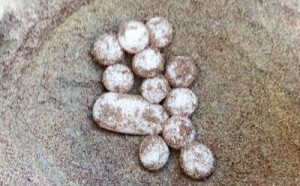



Source – 12/03/2017, The Sunday times, see more at – http://www.sundaytimes.lk/170312/news/mysterious-deaths-of-sea-turtle-232385.html

Wildlife officers, conservationists honoured for their commitment
A wildlife officer receives an award from Minister Gamini Jayawickrema
The Ministry of Wildlife and Sustainable Development has recognised its officers and others for their outstanding efforts at conserving Sri Lanka’s Wildlife. The awards ceremony was held on March 3, under the patronage of President Maithripala Sirisena, to mark ‘World Wildlife Day’.
The awards scheme was named in Sinhala as ‘Seva Prasadini’
recognising Wildlife officers who went the extra mile in conserving Sri Lanka’s Wildlife, under four categories, with officers of the Dept of Zoological Gardens and the Dept of Botanical Gardens that comes under the ministry too, given due consideration. Retired Wildlife officers who,
during their service, went above and beyond the call of duty, in
protecting the Wildlife, were also awarded.
The Wildlife Dept lost the second highest number of officers in operation, among government institutes, after the Armed forces. A number of its officers were also killed on duty in Wilpattu and Yala during the war. Their attempts at keeping the protected areas free of poachers, also took the lives of many officers. and were recognised at the ceremony.
Efforts at mitigating Human-Elephant Conflict (HEC) were given priority in the selection process, as was evident in those who received the awards. The work of Civil Defense Forces in assisting Wildlife officers to mitigate the HEC, where elephant confrontation is high, was also recognised.
Wildlife Minister Gamini Jayawickrema Perera said Government decided to grant ‘Samurdhi Benefits’ for families whose breadwinner was killed by elephants. Marking the occasion, the Minister presented the first Samurdhi certificate to a wife of a farmer killed by wild elephants. He said the Government is also working on increasing the compensation to next-of-kin of officers killed whilst on duty.
About 3,500 persons work in agencies under the Ministry of Wildlife and Sustainable Development, resulting in a daily revenue of Rs 20 million to government coffers. Deputy Minister Sumedha P. Jayasena said there is shortage of about 1,400 Wildlife officers, commending the Dept for carrying out their task with the limited resources.

In addition to Wildlife officers, several experts in Wildlife Conservation too were honoured under “Vishishta Sewa Prasadini” (Distinguished Service Awards). Dedicated professionals in Conservation such as renowned elephant researcher Dr Prithiviraj Fernando, former Director General- Dept of Botanic Gardens, Dr Siril Wijesundara, veteran Environmental Lawyer, Jagath Gunawardane, Herpetologist Mendis Wickremasinghe who discovered a number of new species, were among those honoured.
For his contribution towards ‘Communicating Wildlife’, the Sunday Times Environment Correspondent Malaka Rodrigo was honoured under “Vishishta Seva Prasadini” (Distinguished Service Awards) Excellent Service award category.
Source – 12.03,2017, The Sunday Times, see more at – http://www.sundaytimes.lk/170312/news/wildlife-officers-conservationists-honoured-for-their-commitment-232412.html

Fishermen playing deadly games with dolphins
A video captured by an onlooker shows some of the dolphins being hauled in while alive
By Malaka Rodrigo
Deaths of a dozen dolphins trapped in a beach seine net (ma dela) last Wednesday evening in Trincomalee has stirred strong emotions.
A video captured by an onlooker shows some of the dolphins being hauled in while alive, contesting claims by fishermen that they had released some.
Nine Trincomalee fishermen who were arrested were denied bail and are in remand custody.
All marine mammals in Sri Lanka are protected under the Flora and Fauna Ordinance, and Fisheries Act. The fishermen were arrested under the provisions of these laws, said Roshan Aluthgamage, the OIC of Trincomalee Harbour.
The dolphins had been caught near the inner harbour. The fishermen who had come from nearby Manayaweli village started laying the net around 4 pm and it was dark around 7pm when they pulled the net in. According to the fishermen, they realized dolphins were in the net but that it was too late.
Beach seine nets are known as ‘ma dela’ in Sinhala. It is a fishing net laid from the shore and is a traditional fishing method, which is legal. The fishermen also had a license and it is also possible that they did not target the dolphins. But as it is a crime to kill the protected marine mammal, they were arrested, Aluthgamage said.
Marine mammal expert Ranil Nanayakkara, identified the victims as spinner dolphins (stenella longirostris), the most acrobatic of all dolphins.
In 2013, the killing of 40 dolphins as a result of an illegal purse seine net, called the ‘laila net’ in Kalpitiya, highlighted the need to look at fishing practices around Sri Lanka.
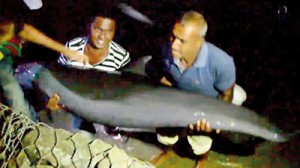
There are suspicions that hundreds of dolphins are getting killed in fishing nets.
As it is illegal to kill a dolphin or possess its flesh, Sri Lankan fishermen also tie their tails to sand bags and sink the carcasses, say marine activist Upali Mallikarachchi.
Often the flesh is used as bait, he said.
There are occasions when fishermen target dolphins. Two fishermen in Mirissa were arrested last year in the possession of a dolphin thay had harpooned, according to news reports.
Senior Lecturer of the Department of Oceanography and Marine Geology University of Ruhuna, Dr Terney Pradeep Kumara, said dolphins alive are more worth than dead pointing out the benefits from the whale and dolphin watching industry. The worldwide whale and dolphin tourism industry was estimated to be worth US$2 billion in 2010. he said Sri Lanka stands to lose a good opportunity.
Travice Ondaatjie, the Conservation Officer of the Sri Lanka Sub Aqua Club, said that killings in Trincomalee show the need for more effective monitoring by the Ministry of Fisheries and law enforcement. A few years back many more dolphin were killed in Kalpitiya, too. But were the perpetrators punished? he asks.
Dr Pradeep Kumara, general manager of the Marine Environment Protection Authority, urged greater cooperation among government agencies. He suggests a coordinating framework involving the Department of Wildlife Conservation, Department of Fisheries, National Aquatic Resources Research and Development Agency, Central Environment Authority, and even the Forest Department as they manage some of the mangroves, to protect marine resources.
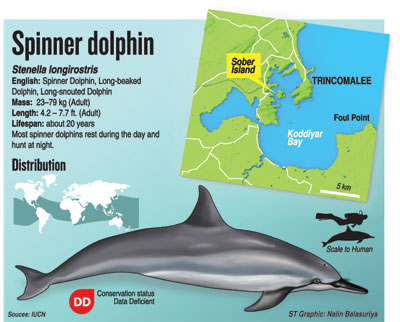
Source – 12/03/2017, The Sunday Times, See more at – http://www.sundaytimes.lk/170312/news/fishermen-playing-deadly-games-with-dolphins-232419.html

Stop landfilling and building on reservation land: Farmers in Kataragama
Unauthorised constructions on reservation lands
Pix and text by Janath de Silva
armers’ Associations in Kataragama have petitioned the Environmental Unit of the Presidential Secretariat alleging that their cultivation plots adjacent to traditional irrigation tanks are being indiscriminately destroyed to make way for the fast expanding tourism industry.
They allege marshy wetlands are being filled to build hotels, rest houses and restaurants and that around 1000 acres of irrigation land would be destroyed if this landfill continued.
The Grama Niladhari divisions worst affected include Kataragama, Sella Kataragama, Kandasurindugama, Detagamuwa and Karavile covering the Kataragama Divisional Zone.
Businessmen from the towns are coming to their villages and threatening the livelihood of around 5000 families. The filling of irrigation tanks and the river basin is making paddy cultivation more and more difficult, Janasetha Farmers’ Association Secretary, W.A.K.Piyadasa said. He added generations have lived in these areas using water from these tanks and they have to be protected.
Anyone who comes to Kataragama or Detagamuwa can witness the construction of parapet walls coming up around hotels, guest houses and swimming pools that are being built. These have been mentioned in the petition submitted to the President and the Prime Minister, Mr. Piyadasa said.
He alleged that the landfilling has affected Goyagala wewa, Kohombha wewa, Chandere wewa, Kukulkatuwa wewa, Gerikatu wewa, Samurdhi wewa and the Akkara Visse wewa and the reservation areas have been forcefully encroached upon.
The farmers allege that the businessmen have prepared forged documents to show ownership of these reservation areas.
Janasetha Farmers’ Association president, Chief Incumbent of the Kirivehera, Kataragama, Ven. Kobawaka Daminda Thera said they had informed the authorities in writing about these activities.
He said the Goyagala wewa irrigated some 125 acres of paddy and sustained 48 farming families. The water capacity of this tank had drastically reduced due to unauthorised filling. “This is only one example. But the situation is similar with regard to 20 irrigation tanks surrounding the divisional area. We hope that the Presidential Task Force on Environment will carryout a probe on the matter,” the Thera said.

Meanwhile Kataragama Divisional Agrarian Services Development Officer Sunil Sriyananda said he had received similar complaints. “These lands are managed by the Divisional Secretariat” he said, adding that the tank reservation areas need to be surveyed before claims of encroachment of these areas are looked into,” he said.
Commenting on the matter, Kataragama Divisional Secretary, S. Weerakoon said the land area under the Divisional Secretariat is around 80,000 acres and about 80% of this land has been demarcated as forest reservations. “Some people prepare forged documents and sell lands to businessmen,” he said.
Moneragala District Secretary Mrs. D.S.Padmakularuriya conceded that unauthorised constructions had come up in these reservation areas in Detagamuwa.
Source- 12/03/2017, The Sunday Times, See more at – http://www.sundaytimes.lk/170312/news/stop-landfilling-and-building-on-reservation-land-farmers-in-kataragama-232452.html

CMC insists on Meethotamulla dumping, but lawmaker told of alternative
By Chrishanthi Christopher
While a lawmaker who represents people of Meethotamulla says he has been told that Colombo’s municipal officials will look for an alternative site to dump garbage from Saturday, the head of the Colombo Municipal Council insists that waste will continue to be hauled to the foul mountain regardless of resident’s warnings to stop the dumping.
The garbage mountain at Meethotamulla has swelled to 180 feet with around three million tonnes of waste, said United National Party, lawmaker, S M Marikar, who represents people of the area.
He said that following a meeting with Minister Faizer Mustapha on Tuesday it was agreed that the CMC will find an alternative dump site from Saturday.
Despite the ultimatum issued by Meethotumulla residents, CMC Commissioner V K A Anura, said waste will be taken to Meethotamulla. “We will continue to dump there, we have no other place.’’
Meanwhile, environmental police have been asked to keep the streets clean.
A Western Province official said environmental police and local authorities have been asked to sort out the garbage issue, as advised by the president’s office, following a meeting on Friday involving the Minister of Megapolis and Western Development, Patali Champika Ranawaka, Local Government and Provincial Councils, Minister Faizer Mustapha, Chief Minister of the Western Province, Isura Devapriya and local authority officials. The involvement of environmental police was requested by President Maithripala Sirisena, said Western Province Chief Minister, Isura Devapriya.
The meeting follows protests by Meethotamulla and Wellampitiya residents who are determined not to allow the CMC to dump any more garbage in their area.
Also, the Colombo Archdiocese said it had been assured that the CMC will not dump garbage in Ja-Ela.
Earlier, the CMC had plans to move the Meethotamulla garbage to a site in Othekelle Ja-ela following a court order to clear the stinking Meethotamulla mountain.
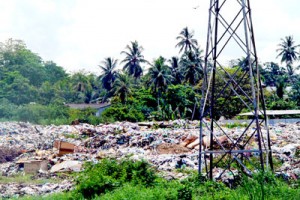
But residents supported by Buddhist monks and the Catholic Church brought it to a halt.
Last week, in a joint statement by the Archbishop of Colombo, Cardinal Malcolm Ranjith and Ven Kotugoda Dhammawasa Maha Thera, said President Maithripala Sirisena had assured that Colombo’s garbage will not be dumped in Ja-ela.
Media spokesperson, Fr Edmund Tilakaratne, said the the President had intervened.
The CMC disposes garbage in sites leased from private landowners.
An estimated 58 unmanaged waste dumps have been identified by environmentalists.
The Megapolis Ministry said there are plans to move the garbage from Colombo to a lime stone excavation site in Arawakaru, Puttalam.
Additional Secretary, Madhava Waidyaratne, said there are plans to convert dump sites at Meethotamulla and Bloemendhal Street into urban gardens or parks.
Source – 12/03/2017, The Sunday Times, See more at – http://www.sundaytimes.lk/170312/news/cmc-insists-on-meethotamulla-dumping-but-lawmaker-told-of-alternative-232523.html
Wildlife Department nurses polythene-ingested elephant to heath
The Giritale Wildlife Department nursed to health an elephant that was found to have consumed vast amounts of polythene.
The elephant was found lying in a swamp at Manampitiya, Nelumwila on January 29.
The Giritale Wildlife Department said the elephant was moved out of the swamp with a backhoe and treated with 30 bottles of saline.
Giritale Wildlife Department veterinary surgeon said the elephant had discharged 40 kilogrammes of polythene, after being given 40 litres of water and 3 litres of coconut oil.
http://www.dailynews.lk/2017/02/07/local/106999/wildlife-department-nurses-polythene-ingested-elephant-heath?page=7












